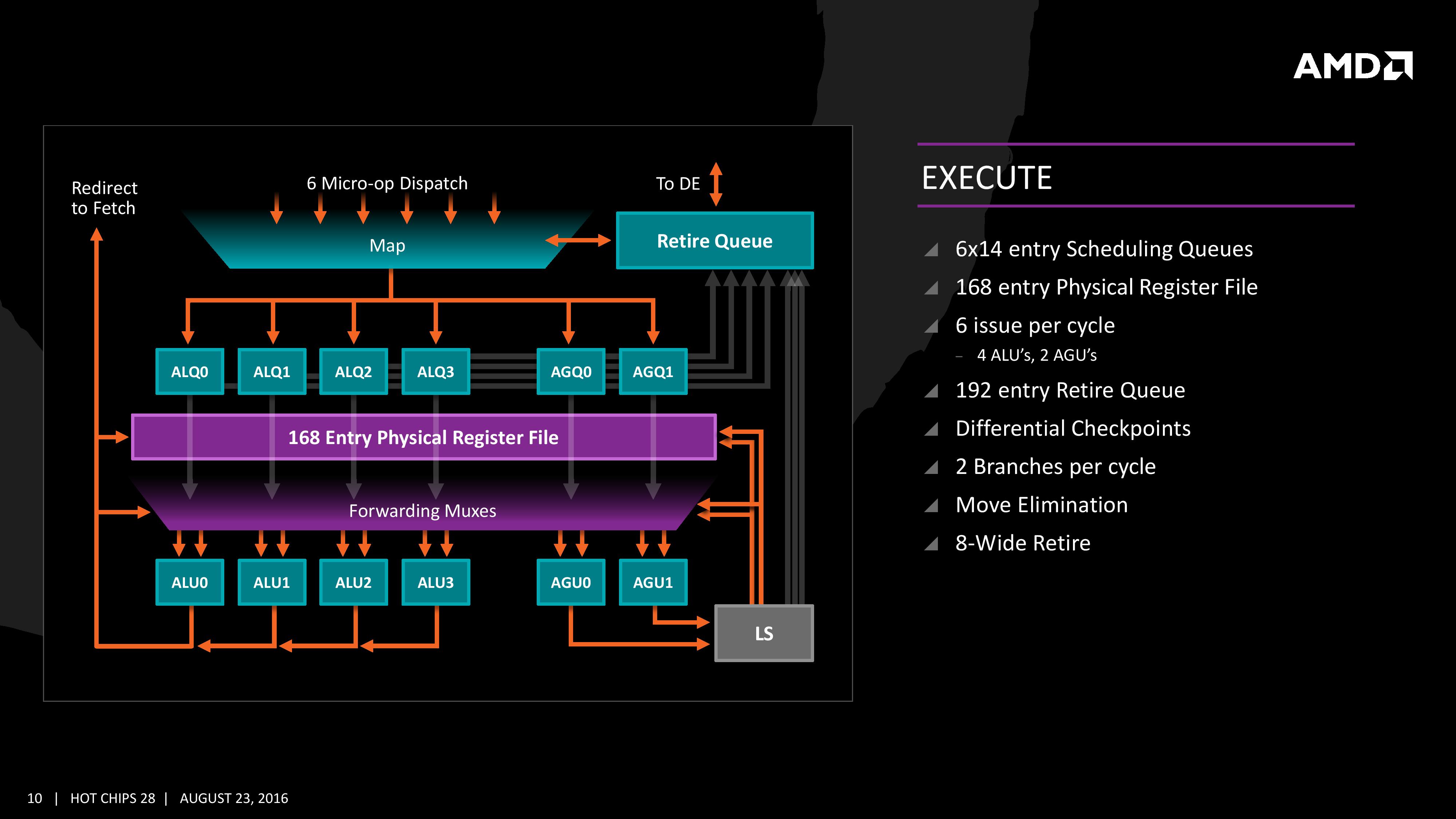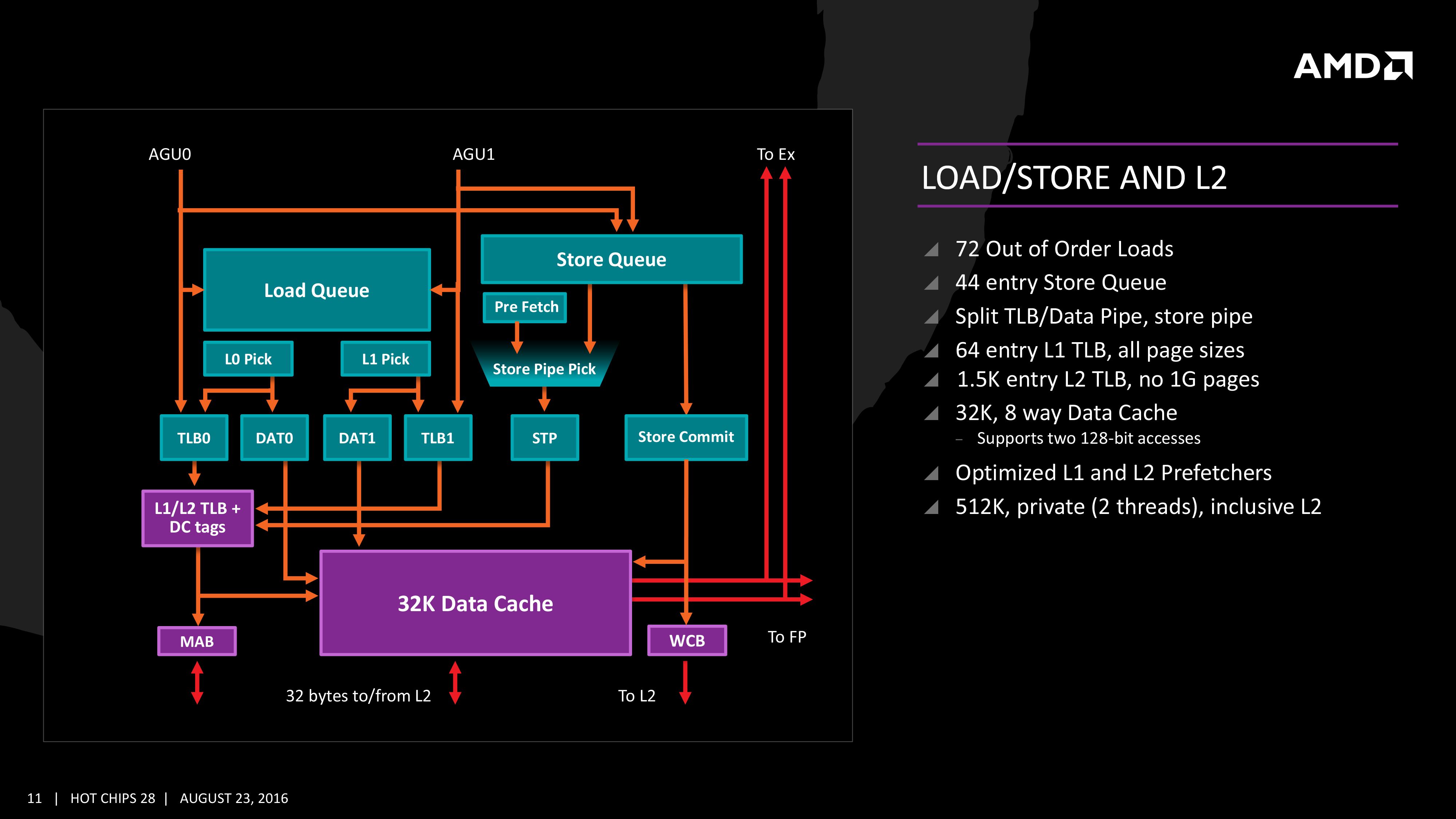AMD Zen Microarchiture Part 2: Extracting Instruction-Level Parallelism
by Ian Cutress on August 23, 2016 8:45 PM EST- Posted in
- CPUs
- AMD
- x86
- Zen
- Microarchitecture
Execution, Load/Store, INT and FP Scheduling
The execution of micro-ops get filters into the Integer (INT) and Floating Point (FP) parts of the core, which each have different pipes and execution ports. First up is the Integer pipe which affords a 168-entry register file which forwards into four arithmetic logic units and two address generation units. This allows the core to schedule six micro-ops/cycle, and each execution port has its own 14-entry schedule queue.
The INT unit can work on two branches per cycle, but it should be noted that not all the ALUs are equal. Only two ALUs are capable of branches, one of the ALUs can perform IMUL operations (signed multiply), and only one can do CRC operations. There are other limitations as well, but broadly we are told that the ALUs are symmetric except for a few focused operations. Exactly what operations will be disclosed closer to the launch date.
The INT pipe will keep track of branching instructions with differential checkpoints, to cut down on storing redundant data between branches (saves queue entries and power), but can also perform Move Elimination. This is where a simple mov command between two registers occurs – instead of inflicting a high energy loop around the core to physically move the single instruction, the core adjusts the pointers to the registers instead and essentially applies a new mapping table, which is a lower power operation.
Both INT and FP units have direct access to the retire queue, which is 192-entry and can retire 8 instructions per cycle. In some previous x86 CPU designs, the retire unit was a limiting factor for extracting peak performance, and so having it retire quicker than dispatch should keep the queue relatively empty and not near the limit.
The Load/Store Units are accessible from both AGUs simultaneously, and will support 72 out-of-order loads. Overall, as mentioned before, the core can perform two 16B loads (2x128-bit) and one 16B store per cycle, with the latter relying on a 44-entry Store queue. The TLB buffer for the L2 cache for already decoded addresses is two level here, with the L1 TLB supporting 64-entry at all page sizes and the L2 TLB going for 1.5K-entry with no 1G pages. The TLB and data pipes are split in this design, which relies on tags to determine if the data is in the cache or to start the data prefetch earlier in the pipeline.
The data cache here also has direct access to the main L2 cache at 32 Bytes/cycle, with the 512 KB 8-way L2 cache being private to the core and inclusive. When data resides back in L1 it can be processed back to either the INT or the FP pipes as required.
Moving onto the floating point part of the core, and the first thing to notice is that there are two scheduling queues here. These are listed as ‘schedulable’ and ‘non-schedulable’ queues with lower power operation when certain micro-ops are in play, but also allows the backup queue to sort out parts of the dispatch in advance via the LDCVT. The register file is 160 entry, with direct FP to INT transfers as required, as well as supporting accelerated recovery on flushes (when data is written to a cache further back in the hierarchy to make room).
The FP Unit uses four pipes rather than three on Excavator, and we are told that the latency in Zen is reduced as well for operations (though more information on this will come at a later date). We have two MUL and two ADD in the FP unit, capable of joining to form two 128-bit FMACs, but not one 256-bit AVX. In order to do AVX, the unit will split the operations accordingly. On the counter side each core will have 2 AES units for cryptography as well as decode support for SSE, AVX1/2, SHA and legacy mmx/x87 compliant code.













106 Comments
View All Comments
bcronce - Tuesday, August 23, 2016 - link
Exclusive L3 cache makes better use of space, but requires snooping other core's L2 caches for data. If the L3 cache has all of the data all of the L2 cache has, then you only need to check one place.This is important when you're trying to synchronize threads since locks are shared memory locations that each core is attempting to read and update. Common types of thread safe data-structures can take some pretty big performance scaling hits. Of course you can work around this in your data-structure.
One research paper that I read showed exclusive caches having twice the latency of inclusive when snooping was required. If your data-structure has a scaling that works well up to 16 cores on Intel's inclusive cache, it may cap out around 8 cores on AMD's exclusive, thanks to Amdahl's law.
Cache snooping gets slower as more cores are added. Gotta check them all.
deltaFx2 - Tuesday, August 23, 2016 - link
@bconce: Except that Intel doesn't do strictly inclusive caches either. Intel's caches are neither-inclusive-nor-exclusive (afaik), in which data is inserted into both L2 and L3, but evicted independently. So you have to check L2 and L3 independently, same as the exclusive cache. Strictly-inclusive caches have many bad properties, a few that come to mind immediately (1) False evictions of lines: If a block constantly hits in L2, the LRU in L3 is not updated. If the block then becomes the oldest in L3 and is evicted, it must be evicted in L2 as well, resulting in a miss all the way to memory (2) Associativity of the L3 cache must be at least the sum of the associativity of the L2 caches hanging off it, otherwise it will constrain the associativity of the L2 caches. Hence neither-inclusive-nor-exclusive, or strictly exclusive.Exclusive caches are harder to build, true, because you have to manage exclusivity. That doesn't explain Ian's comment about them being less efficient.
68k - Wednesday, August 24, 2016 - link
The Intel manual state that"The shared L3 cache is writeback and inclusive, such that a cache line that exists in either L1 data cache, L1 instruction cache, unified L2 cache also exists in L3."
That is, the L3-cache is strictly inclusive with anything stored in the core local L2/L1-caches. So it is enough to check L3 to see whether the cache-line is in use by any other core sharing the L3.
bcronce - Wednesday, August 24, 2016 - link
@68kThanks for looking it up. I only remembered Intel talking talking about this years ago when they made the design decision in order to minimize latency. Certain operations are extremely latency sensitive, like thread synchronizations.
The strange thing is AMD is pushing for so many cores, but then chooses a cache design that makes sharing data more expensive. What they did gain is exclusive caches tend to have more bandwidth and are great for independent threads with little sharing. It's a trade off. Nothing is free, pros and cons everywhere.
deltaFx2 - Wednesday, August 24, 2016 - link
@68k,@bcronce: I guess I haven't looked up Intel's latest and greatest cache organization :) I do recall though that Neither-incl-nor-exclusive was their scheme for quite a while, probably until Sandy Bridge. Perhaps that explains why their L2 cache went from 8-way to 4-way in SkyLake; the extra associativity cannot be effectively utilized with strict inclusion as you keep adding more cores (a single set in L3 maps to a unique set in L2. If you have 16 way L3, only 16 lines that map to that set in L3 can reside in the L2s. Obviously, multiple L3 sets map to the same L2 set, so this is somewhat mitigated, but it is a glass-jaw).The nice thing about Intel's organization is that it's a monolithic L3 with variable latency to slices, as opposed to AMD's distributed L3. That probably is what adds the latency (if it does) on cache-to-cache transfers, not the inclusive-vs-exclusive, or the inclusive cache acting as a probe filter. You could just as easily add a separate probe filter to avoid unnecessary coherence lookups. Would you point me to that paper you quoted earlier? I have a hard time believing that the problem is the exclusive cache itself, and not the organization of the cache. Anyway, I don't know enough about AMD's design to comment, so I'll leave it at that. Thanks!
intangir - Wednesday, August 24, 2016 - link
As far as I know, since Nehalem Intel's L3 caches have been fully inclusive of L1+L2, but the L1 and L2 caches are neither inclusive nor exclusive with respect to each other.Ryan Smith - Tuesday, August 23, 2016 - link
Right you are. That's a typo on our end, and in the deep dive section on cache you can see why it's exclusive. As for the first page, I've corrected the typo.looncraz - Wednesday, August 24, 2016 - link
Zen's L3 is "mostly exclusive." This changes things up a bit - it isn't a pure victim cache and will probably contain data used between multiple cores. The first access will be slower as the data is snooped from another core's L2, but then that data will be mirrored in the L3. The coherent data fabric which links multiple core complexes adds a whole new level of complexity for sharing data between cores, but I suspect a mechanism exists to synchronize global data between the L3 caches, so global data will have a copy in each L3 and actions on global data will incur a latency penalty, but nothing compared to snooping L2s across multiple core complexes.NikosD - Wednesday, August 24, 2016 - link
It seems that AMD did its job right this time.Most of the CPU features are in between Broadwell and Skylake architectures and this is extremely important and fast, with the exception of AVX/AVX2 instructions that are executed in 128bit chunks instead of 256bit.
Of course we have to wait and see latencies and throughput of the rest of arithmetic instructions, but all these are just details.
I think with Zen we will all owe a lot to AMD like the older days of 64bit CPUs and OS.
This time the revolution will be the affordable true 8 core/ 16 thread CPU with no GPU inside for the first time in desktop.
The key point here is price, in order to be affordable. Not like High-End Desktop systems of Intel.
That move will force Intel to accept the fact that we, as customers, want 8 cores in our CPUs like 64bit CPUs and OS back in the past that Intel offered only with Itanium.
All in all, AMD could possibly hold in its hands a true winner, from laptops to servers that brings us memories of AMD Athlon and Opteron CPUs.
Well done AMD!
Michael Bay - Wednesday, August 24, 2016 - link
Do we, though? General purpose software like word processors and such is literally indistinguishable on 2 and 4 cores, and a lot of things on content creation side are already accelerated by GPU.There are games of course, but CPU stopped being a bottleneck there long time ago.